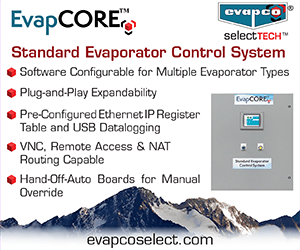From the Technical Director
by Eric Smith, P.E., LEED AP, IIAR Technical Director
Consultants have called the IIAR headquarters a few times recently with the following question: “I have an owner who has a building with two ammonia refrigeration systems. The systems are independent of each other. Both systems have charges of less than 10,000 lbs. of ammonia, but if the charges were added, the total inventory would meet or exceed the 10,000 lb. threshold limit established by federal OSHA Process Safety Management (PSM) and EPA Risk Management (RM) program requirements. Should a PSM and RM program be developed for this facility?”The short answer is probably, but not necessarily. The OSHA PSM standard requires a facility to develop a PSM program if the facility contains “A process which involves a chemical at or above the specified threshold quantities listed in Appendix A…” The threshold level for ammonia listed in Appendix A is 10,000 pounds. The OSHA PSM standard provides the following definition for a process:
“Process” means any activity involving a highly hazardous chemical including any use, storage, manufacturing, handling, or the on-site movement of such chemicals, or combination of these activities. For purposes of this definition, any group of vessels which are interconnected and separate vessels which are located such that a highly hazardous chemical could be involved in a potential release shall be considered a single process.
EPA’s definition of process is identical to the definition of process under the OSHA PSM standard.
Understanding the definition of process is important in determining whether you are covered by the PSM Standard and the RM Program regulation. What this means for end users is that:
- If you have a single ammonia refrigeration system in the United States and this system contains 10,000 pounds or more of anhydrous ammonia that system is covered by federal PSM and RM Program requirements.
- If you have two (or more) separate ammonia refrigeration systems which are interconnected the separate systems should be considered a single “process”. If the combined ammonia inventory is above 10,000 pounds the separate systems are covered by federal PSM and RM Program requirements. The connections between the systems need not be permanent. Even if two or more vessels are connected occasionally, they are considered a single process for the purposes of determining whether a threshold quantity is present.
- If you have two (or more) unconnected ammonia refrigeration systems, you will have to determine whether the systems need to be considered “co-located”. The key question is whether the systems are located such that they could be involved in a single release. For example, could a release from one of the systems lead to a release from the other system? Alternatively could a single event (such as a fire, explosion, or collapse of a building) have the potential to release ammonia from multiple ammonia refrigeration systems? You must determine if there is a credible scenario that could lead to an ammonia release of 10,000 pounds or more from the multiple systems.
A release from one ammonia refrigeration system will not normally lead to a release from a different system unless a vessel or pipe catastrophically fails sending metal fragments into the other system. Co-located ammonia refrigeration systems could, however, be involved in a release caused by a fire or explosion from another source, for example a fire which affects the entire building or a roof collapse. You should not dismiss the possibility of fire spreading based on the assumption that the Fire Department or your sprinkler system will prevent any spreading. You should ask yourself how far the fire would spread if the worst happens – the Fire Department decides to let the fire burn our or water is not available. Thus if you have separate systems which could be affected by the same accident (i.e. the systems are considered co-located) and the combined ammonia inventory is above 10,000 pounds the separate systems are covered by federal PSM and RM Program requirements.
- If you have two (or more) ammonia refrigeration systems which are not interconnected and are not co-located and the anhydrous ammonia inventory of each system is below 10,000 pounds, you will not have to comply with the federal PSM standard or the RM program regulation. You may, however, still have to comply with state regulatory requirements. In addition, the IIAR suggests that you voluntarily comply with Ammonia Refrigeration Management (ARM) program. The ARM program is a voluntary program developed by the IIAR designed to help facilities manage their ammonia refrigeration system in a safe and responsible manner.













